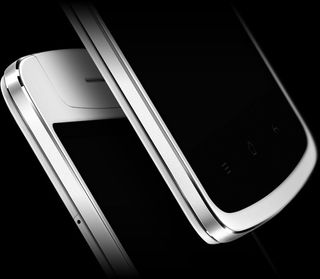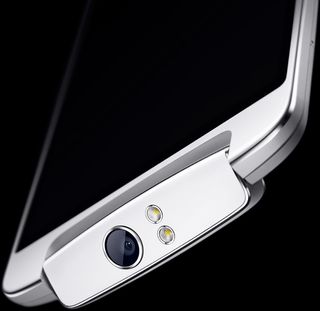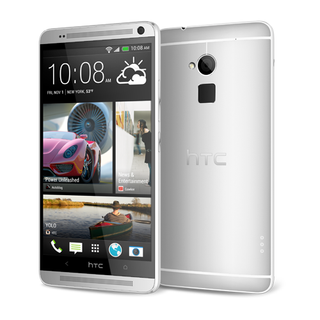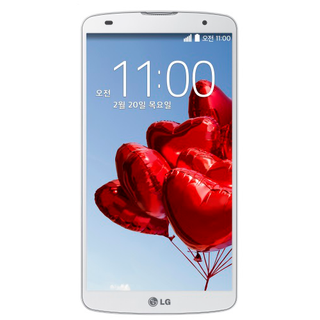Oppo N1 Review: Future-Looking Phablet Or Oversized Flop?
Oppo's N1 sports a unique pivoting camera, a large-format display, and two different operating system options. Are those features enough to make up for an older hardware platform and dicey software optimization in a sea of compelling competition?
Why you can trust Tom's Hardware
A Phablet For A Niche Market
With its N1, Oppo hopes the light from its large 5.9" screen acts as a beacon, luring consumers to the company's phablet on a global scale. But, simply making a phone bigger isn’t enough. For the N1 to join the phablet elite, it needs a stylish appearance, cutting-edge performance, and a unique set of features that complement the spacious screen and compensate for a loss of portability.
The N1’s hybrid aluminum and plastic chassis gives it a premium feel. And the matte white finish, combined with tasteful chrome accents, completes a stylish package that competes with the best-designed smartphones.

Inside the attractive chassis is a Snapdragon 600 SoC with four Krait 300 cores and Adreno 320 graphics, matched up to 2 GB of RAM. The choice of second-tier silicon handicaps the N1 relative to its peers, most of which sport a faster Snapdragon 800 SoC. Unsurprisingly, the N1 fails to distinguish itself in any of our CPU or GPU benchmarks.

Even though the N1’s performance doesn't garner any honors, it's still a capable smartphone. During my time with the N1, I never felt like I was waiting on the hardware to catch up. Frame rates remained playable in the few games I tried, and UI scrolling performance was generally smooth once content finished loading. The only stuttering I encountered was app-specific (Evernote was a bit choppy), so I can’t pin blame on the SoC, per se. While the N1 might not be the best choice for hardcore games or taxing software, it’s more than adequate for media consumption, casual gaming, and general productivity apps.
The N1 fails to secure any bonus points for its lack of a microSD slot, and the big 3610 mAh battery isn’t removable either. However, the power source's extra capacity overcomes the power draw from a 5.9" IPS display, helping the N1 charge into first place through several battery life benchmarks.
Oppo's open OS policy is refreshing and commendable. Recognizing the impossibility of creating one operating environment able to satisfy everyone, the company provides two solid, but very different offerings.

ColorOS makes it easy to personalize your N1, and the included gesture support helps automate common tasks. Still early in its development, the ColorOS UI design needs further refinement, and many of its features seem incomplete (App Encryption and Data Saving) or are unworkable in their current state (Guest Mode).
CyanogenMod eschews the extensive skinning used in ColorOS for a more Google-like experience that should appeal to Android purists and power users. Its tunable interface, support for Profiles, and true encryption are all great features, but you lose the gesture control and support for the N1's unique hardware offered by ColorOS.

The choice of operating system must be decided by supported features and aesthetics, since our benchmark results don't identify a clear winner in performance. ColorOS and CyanogenMod exhibit similar performance in the CPU benchmarks. Oppo’s OS handles the photo editing tasks in MobileXPRT 2013 a little better, but CyanogenMod shows a clear performance advantage in the Geekbench 3 Multi-Core test. There is no significant difference between the two in our CPU-dependent Web browsing tests.
CyanogenMod, benefitting from the enhanced graphics engine in its newer Android 4.3 core, achieves slightly better scores in a few of the GPU metrics. The difference in real-world gaming should be negligible though, except for a few very specific scenarios. The CompuBenchRS benchmark, which tests GPU compute performance, is the one test that scores both packages quite differently. ColorOS is the big loser, unable to run RenderScript code on the Adreno GPU. We also discovered an issue where ColorOS doesn’t properly utilize all four CPU cores under heavy load. This isn't the result of thermal throttling and the cores weren’t completely disabled, since they briefly powered up during system events. ColorOS either uses a buggy driver or a mistuned power management routine. While ColorOS limits the N1's Snapdragon 600 to dual-core performance in some scenarios, the lack of real-world, threaded applications means the issue isn’t a deal breaker. It's only noticeable when running specific benchmarks or certain games.
Ultimately, the N1's defining feature isn't its large screen or choice of operating systems, but rather that unique rotating camera. The front-facing camera was once an afterthought. But that's quickly changing. The Internet shows that while people like taking pictures of cats, they love taking pictures of themselves. Using the N1, your front-facing shots can look just as good as the rear-facing ones. The rotating camera module serves its intended purpose well and exhibits excellent craftsmanship.

A well-designed product isn’t just about the quantity of unique features, but the quality of their execution. Mediocre picture quality dulls the shine of Oppo's versatile, rotating camera. The iPhone 5s (with a good, but not excellent camera) produces superior images under all lighting conditions compared to the N1, which has issues with properly setting exposure and white balance, excess noise, and a tendency to create blurry, unfocused pictures.

O-Touch, the secondary touch panel on the back of the N1 that promises to ease one-handed use, is also marred by poor execution. An active area that’s too small and difficult to locate, slow scroll rate without any momentum, and frequent unintended inputs severely limit its usefulness when using ColorOS. Performance is even worse with CyanogenMod due to an immature software driver.
Starting at $599 for 16 GB of internal storage and $649 for 32 GB, the N1 hits the median price point for an unlocked phablet. For about the same price though, both the Samsung Galaxy Note 3 and LG G Pro 2 give you a faster Snapdragon 800 SoC, support for Cat4 LTE, a microSD slot, and a removable battery. The Note 3, with its S Pen and Multi Window multi-tasking, and HTC One max, with its premium speakers and enhanced media-editing software, both make good use of their large-format screens. The N1, on the other hand, fails to capitalize on that big display. Its rotating camera, the one feature setting it apart from other smartphones, would work just as well on a phone with a smaller screen. So, you end up carrying around a larger, heavier phone for the sole benefit of viewing content more easily.
The Oppo N1 is not a bad phone, but with so many strong contenders in the phablet arena, it’s difficult to recommend unless you are a selfie fanatic or just love the rotating camera. Still, Oppo demonstrates a penchant for creativity and industrial design with its N1, and I look forward to seeing what this emerging company does in the future.
Follow Matt and Tom's Hardware on Twitter
Current page: A Phablet For A Niche Market
Prev Page Results: Battery Life And PerformanceStay on the Cutting Edge
Join the experts who read Tom's Hardware for the inside track on enthusiast PC tech news — and have for over 25 years. We'll send breaking news and in-depth reviews of CPUs, GPUs, AI, maker hardware and more straight to your inbox.
-
wavetrex Just a small comment about OLED, even if this might not be the place to write about it.Reply
Probably due to to imperfections in the transistors that control the OLED pixels, there is a very faint but perceptible in deep darkness leakage of energy toward the pixels.
Yes, doesn't compare to the obvious light bleed of any TFT display, but the OLED "off" pixels are not truly off, they have a 0.00something-small level of light which could theoretically be measured by some very sensitive equipment.
The eyes are certainly capable of seeing it... -
InvalidError Putting both flash LEDs on the same side so close to the image sensor seems like a missed opportunity to me: putting one LED close to each hinge with the camera in the middle would provide more even lighting and softer shadows.Reply
With the mostly passable image quality, that would not help the N1 much though. -
Onus Please don't put the letters "p" "h" "a" "b" "l" "e" "t" together in that order and treat it like a word.Reply
-
WyomingKnott @onusReply
First time I read the term I had the image of holding my 10" Asus pad up to my face and talking into it. I suppose it's better than a shoe; cleaner, too. -
shahbaz200 Bad GPU, doesn't works well on this device, poor performance, other than that its good device.Reply -
BlankInsanity please respect my opinion, but I don't see why phones need to go bigger. i the 90s phones used to be huge and this was a problem for mobility and so as the years went by they created smaller form factor phones. Now here we are repeating that mistake. A phone is ment to make a small footprint when hidden on it's user such as a pocket. You don't put your tablet in your pocket, I don't see why'd you make a phone out of it. this is just my opinionReply -
jankeke "please respect my opinion, but I don't see why phones need to go bigger. i the 90s phones used to be huge and this was a problem for mobility and so as the years went by they created smaller form factor phones. Now here we are repeating that mistake. A phone is ment to make a small footprint when hidden on it's user such as a pocket. You don't put your tablet in your pocket, I don't see why'd you make a phone out of it. this is just my opinion "Reply
True but people couldn't watch porn on their phones back then so it made sense to make them as small as possible. Not so now ... ^^ -
Matthew DiGiacomo No offense Tom's Hardware but why are you reviewing this phone now? It's outdated and been on the market for almost 8 months.. No one really cares about it anymore.Reply -
falchard The Camera is a smart solution meaning you won't need 2 cameras. Obviously it will need tilt support to tell it which direction is up.Reply
No removable battery is a shitty solution. Its the issue all phones face after 2 years, their batteries no longer hold a charge. -
BlankInsanity Reply13717317 said:The Camera is a smart solution meaning you won't need 2 cameras. Obviously it will need tilt support to tell it which direction is up.
No removable battery is a shitty solution. Its the issue all phones face after 2 years, their batteries no longer hold a charge.
lol that's a scam the companies do to force you to buy a new one ;)



